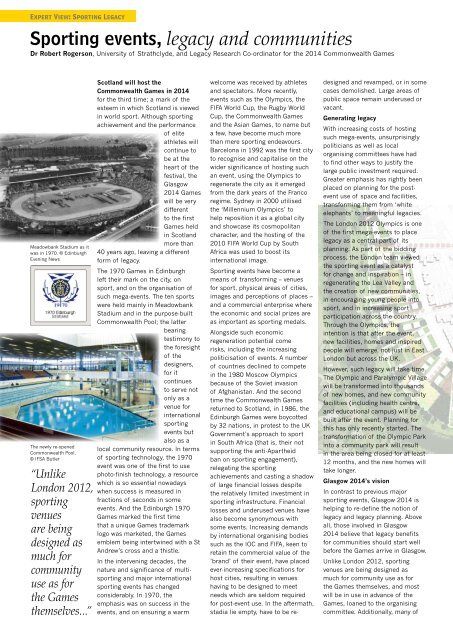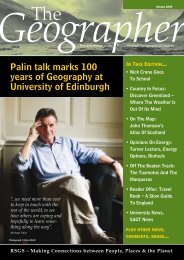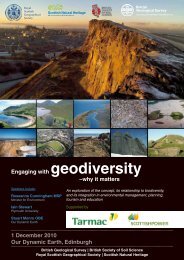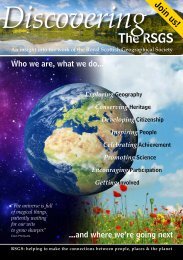Summer - Royal Scottish Geographical Society
Summer - Royal Scottish Geographical Society
Summer - Royal Scottish Geographical Society
Create successful ePaper yourself
Turn your PDF publications into a flip-book with our unique Google optimized e-Paper software.
Expert View: Sporting Legacy<br />
I visited Leptis Magna the other day. I didn’t really know how many Roman sites there are in Libya! Apparently it is the largest<br />
Roman site outside of Italy. Anyway we had it to ourselves basically.....the potential for tourism in this country is massive.<br />
Sporting events, legacy and communities<br />
Dr Robert Rogerson, University of Strathclyde, and Legacy Research Co-ordinator for the 2014 Commonwealth Games<br />
Meadowbank Stadium as it<br />
was in 1970. © Edinburgh<br />
Evening News<br />
The newly re-opened<br />
Commonwealth Pool.<br />
© IFSA Butler<br />
“Unlike<br />
London 2012,<br />
sporting<br />
venues<br />
are being<br />
designed as<br />
much for<br />
community<br />
use as for<br />
the Games<br />
themselves...”<br />
Scotland will host the<br />
Commonwealth Games in 2014<br />
for the third time; a mark of the<br />
esteem in which Scotland is viewed<br />
in world sport. Although sporting<br />
achievement and the performance<br />
of elite<br />
athletes will<br />
continue to<br />
be at the<br />
heart of the<br />
festival, the<br />
Glasgow<br />
2014 Games<br />
will be very<br />
different<br />
to the first<br />
Games held<br />
in Scotland<br />
more than<br />
40 years ago, leaving a different<br />
form of legacy.<br />
The 1970 Games in Edinburgh<br />
left their mark on the city, on<br />
sport, and on the organisation of<br />
such mega-events. The ten sports<br />
were held mainly in Meadowbank<br />
Stadium and in the purpose-built<br />
Commonwealth Pool; the latter<br />
bearing<br />
testimony to<br />
the foresight<br />
of the<br />
designers,<br />
for it<br />
continues<br />
to serve not<br />
only as a<br />
venue for<br />
international<br />
sporting<br />
events but<br />
also as a<br />
local community resource. In terms<br />
of sporting technology, the 1970<br />
event was one of the first to use<br />
photo-finish technology, a resource<br />
which is so essential nowadays<br />
when success is measured in<br />
fractions of seconds in some<br />
events. And the Edinburgh 1970<br />
Games marked the first time<br />
that a unique Games trademark<br />
logo was marketed, the Games<br />
emblem being intertwined with a St<br />
Andrew’s cross and a thistle.<br />
In the intervening decades, the<br />
nature and significance of multisporting<br />
and major international<br />
sporting events has changed<br />
considerably. In 1970, the<br />
emphasis was on success in the<br />
events, and on ensuring a warm<br />
welcome was received by athletes<br />
and spectators. More recently,<br />
events such as the Olympics, the<br />
FIFA World Cup, the Rugby World<br />
Cup, the Commonwealth Games<br />
and the Asian Games, to name but<br />
a few, have become much more<br />
than mere sporting endeavours.<br />
Barcelona in 1992 was the first city<br />
to recognise and capitalise on the<br />
wider significance of hosting such<br />
an event, using the Olympics to<br />
regenerate the city as it emerged<br />
from the dark years of the Franco<br />
regime. Sydney in 2000 utilised<br />
the ‘Millennium Olympics’ to<br />
help reposition it as a global city<br />
and showcase its cosmopolitan<br />
character, and the hosting of the<br />
2010 FIFA World Cup by South<br />
Africa was used to boost its<br />
international image.<br />
Sporting events have become a<br />
means of transforming – venues<br />
for sport, physical areas of cities,<br />
images and perceptions of places –<br />
and a commercial enterprise where<br />
the economic and social prizes are<br />
as important as sporting medals.<br />
Alongside such economic<br />
regeneration potential come<br />
risks, including the increasing<br />
politicisation of events. A number<br />
of countries declined to compete<br />
in the 1980 Moscow Olympics<br />
because of the Soviet invasion<br />
of Afghanistan. And the second<br />
time the Commonwealth Games<br />
returned to Scotland, in 1986, the<br />
Edinburgh Games were boycotted<br />
by 32 nations, in protest to the UK<br />
Government’s approach to sport<br />
in South Africa (that is, their not<br />
supporting the anti-Apartheid<br />
ban on sporting engagement),<br />
relegating the sporting<br />
achievements and casting a shadow<br />
of large financial losses despite<br />
the relatively limited investment in<br />
sporting infrastructure. Financial<br />
losses and underused venues have<br />
also become synonymous with<br />
some events. Increasing demands<br />
by international organising bodies<br />
such as the IOC and FIFA, keen to<br />
retain the commercial value of the<br />
’brand’ of their event, have placed<br />
ever-increasing specifications for<br />
host cities, resulting in venues<br />
having to be designed to meet<br />
needs which are seldom required<br />
for post-event use. In the aftermath,<br />
stadia lie empty, have to be redesigned<br />
and revamped, or in some<br />
cases demolished. Large areas of<br />
public space remain underused or<br />
vacant.<br />
Generating legacy<br />
With increasing costs of hosting<br />
such mega-events, unsurprisingly<br />
politicians as well as local<br />
organising committees have had<br />
to find other ways to justify the<br />
large public investment required.<br />
Greater emphasis has rightly been<br />
placed on planning for the postevent<br />
use of space and facilities,<br />
transforming them from ‘white<br />
elephants’ to meaningful legacies.<br />
The London 2012 Olympics is one<br />
of the first mega-events to place<br />
legacy as a central part of its<br />
planning. As part of the bidding<br />
process, the London team viewed<br />
the sporting event as a catalyst<br />
for change and inspiration – in<br />
regenerating the Lea Valley and<br />
the creation of new communities,<br />
in encouraging young people into<br />
sport, and in increasing sport<br />
participation across the country.<br />
Through the Olympics, the<br />
intention is that after the event,<br />
new facilities, homes and inspired<br />
people will emerge, not just in East<br />
London but across the UK.<br />
However, such legacy will take time.<br />
The Olympic and Paralympic Village<br />
will be transformed into thousands<br />
of new homes, and new community<br />
facilities (including health centre,<br />
and educational campus) will be<br />
built after the event. Planning for<br />
this has only recently started. The<br />
transformation of the Olympic Park<br />
into a community park will result<br />
in the area being closed for at least<br />
12 months, and the new homes will<br />
take longer.<br />
Glasgow 2014’s vision<br />
In contrast to previous major<br />
sporting events, Glasgow 2014 is<br />
helping to re-define the notion of<br />
legacy and legacy planning. Above<br />
all, those involved in Glasgow<br />
2014 believe that legacy benefits<br />
for communities should start well<br />
before the Games arrive in Glasgow.<br />
Unlike London 2012, sporting<br />
venues are being designed as<br />
much for community use as for<br />
the Games themselves, and most<br />
will be in use in advance of the<br />
Games, loaned to the organising<br />
NATO blown-up tanks on the outskirts of<br />
committee. Misrata; Additionally, there are about many 50 of of them.








